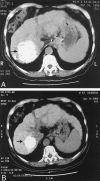Locoregional therapies for hepatocellular carcinoma: a critical review from the surgeon's perspective
- PMID: 11923602
- PMCID: PMC1422461
- DOI: 10.1097/00000658-200204000-00004
Locoregional therapies for hepatocellular carcinoma: a critical review from the surgeon's perspective
Abstract
Objective: This article reviews the current results of various locoregional therapies for hepatocellular carcinoma (HCC), with special reference to the implications for surgeons.
Summary background data: Resection or transplantation is the treatment of choice for HCC, but most patients are not suitable candidates. The past decade has witnessed the development of a variety of locoregional therapies for HCC. Surgeons are faced with the challenge of adopting these therapies in the management of patients with resectable or unresectable HCC.
Methods: A review of relevant English-language articles was undertaken based on a Medline search from January 1990 to August 2001.
Results: Retrospective studies suggested that transarterial chemoembolization is an effective treatment for inoperable HCC, but its perceived benefit for survival has not been substantiated in randomized trials, presumably because its antitumor effect is offset by its adverse effect on liver function. Nonetheless, it remains a widely used palliative treatment for HCC not amenable to resection or ablative therapies, and it also plays an important role as a treatment of postresection recurrence and as a pretransplant therapy for transplantable HCC. Better patient selection, selective segmental chemoembolization, and treatment repetition tailored to tumor response and patient tolerance may improve its benefit-risk ratio. Transarterial radiotherapy is a less available alternative that produces results similar to those of chemoembolization. Percutaneous ethanol injection has gained wide acceptance as a safe and effective treatment for HCCs 3 cm or smaller. Uncertainty in tumor necrosis limits its potential as a curative treatment, but its repeatability allows treatment of recurrence after ablation or resection of HCC that is crucial to prolongation of survival. Cryotherapy affords a better chance of cure because of predictable necrosis even for HCCs larger than 3 cm, but its use is limited by a high complication rate. There has been recent enthusiasm for heat ablation by microwave, radiofrequency, or laser, which provides predictable necrosis with a low complication rate. Preliminary data indicated that radiofrequency ablation is superior to ethanol injection in the radicality of tumor ablation. The advent of more versatile radiofrequency probes has allowed ablation of HCCs larger than 5 cm. Recent studies have suggested that combined transarterial embolization and heat ablation is a promising strategy for large HCCs. Thus far, no randomized trials comparing various thermoablative therapies have been reported. It is also uncertain whether a percutaneous route, laparoscopy, or open surgery affords the best approach for these therapies. Thermoablative therapies have been combined with resection or used to treat postresection recurrence, and they have also been used as a pretransplant therapy. However, the value of such strategies requires further evaluation.
Conclusions: Advances in locoregional therapies have led to a major breakthrough in the management of unresectable HCC, but the exact role of the various modalities needs to be defined by randomized studies. Novel thermoablative techniques provide the surgeon with an exciting opportunity to participate actively in the management of unresectable HCC. Locoregional therapies are also useful adjuncts in the management of patients with resectable or transplantable disease. Hence, surgeons must be equipped with the latest knowledge and techniques of ablative therapy to provide the most appropriate treatment for the wide spectrum of patients with HCC.
Figures




Similar articles
-
Ablative and non-surgical therapies for early and very early hepatocellular carcinoma: a systematic review and network meta-analysis.Health Technol Assess. 2023 Dec;27(29):1-172. doi: 10.3310/GK5221. Health Technol Assess. 2023. PMID: 38149643 Free PMC article.
-
Assessment of the treatment response of HCC.Abdom Imaging. 2011 Jun;36(3):300-14. doi: 10.1007/s00261-011-9683-3. Abdom Imaging. 2011. PMID: 21279353 Review.
-
Systematic review and meta-analysis of survival and disease recurrence after radiofrequency ablation for hepatocellular carcinoma.Br J Surg. 2011 Sep;98(9):1210-24. doi: 10.1002/bjs.7669. Epub 2011 Jul 15. Br J Surg. 2011. PMID: 21766289 Review.
-
Evidence-based diagnosis and locoregional therapy for hepatocellular carcinoma.Expert Rev Gastroenterol Hepatol. 2008 Dec;2(6):761-84. doi: 10.1586/17474124.2.6.761. Expert Rev Gastroenterol Hepatol. 2008. PMID: 19090737 Review.
-
Locoregional Therapies in the Treatment of 3- to 5-cm Hepatocellular Carcinoma: Critical Review of the Literature.AJR Am J Roentgenol. 2020 Jul;215(1):223-234. doi: 10.2214/AJR.19.22098. Epub 2020 Apr 7. AJR Am J Roentgenol. 2020. PMID: 32255691 Review.
Cited by
-
Effects of pre-operative transcatheter arterial chemoembolization for resectable hepatocellular carcinoma: Implication of circulating cancer cells by detection of α-fetoprotein mRNA.Exp Ther Med. 2010 May;1(3):485-491. doi: 10.3892/etm_00000076. Epub 2010 May 1. Exp Ther Med. 2010. PMID: 22993565 Free PMC article.
-
Treatment outcomes of helical intensity-modulated radiotherapy for unresectable hepatocellular carcinoma.Gut Liver. 2013 May;7(3):343-51. doi: 10.5009/gnl.2013.7.3.343. Epub 2013 Apr 9. Gut Liver. 2013. PMID: 23710317 Free PMC article.
-
A review on radiofrequency, microwave and high-intensity focused ultrasound ablations for hepatocellular carcinoma with cirrhosis.Hepatobiliary Surg Nutr. 2021 Apr;10(2):193-209. doi: 10.21037/hbsn.2020.03.11. Hepatobiliary Surg Nutr. 2021. PMID: 33898560 Free PMC article. Review.
-
Long-term outcomes of hepatectomy vs percutaneous ablation for treatment of hepatocellular carcinoma < or =4 cm.World J Gastroenterol. 2006 Jan 28;12(4):546-52. doi: 10.3748/wjg.v12.i4.546. World J Gastroenterol. 2006. PMID: 16489666 Free PMC article.
-
Long-term follow-up outcome of patients undergoing radiofrequency ablation for unresectable hepatocellular carcinoma.World J Surg. 2005 Nov;29(11):1364-73. doi: 10.1007/s00268-005-7829-6. World J Surg. 2005. PMID: 16240062
References
-
- Bosch FX, Ribes J, Borras J. Epidemiology of primary liver cancer. Semin Liver Dis 1999; 19: 271–285. - PubMed
-
- El-Serag HB, Mason AC. Rising incidence of hepatocellular carcinoma in the United States. N Engl J Med 1999; 340: 745–750. - PubMed
-
- Taylor-Robinson SD, Foster GR, Arora S, et al. Increase in primary liver cancer in the UK, 1979–94. Lancet 1997; 350: 1142–1143. - PubMed
-
- Torzilli G, Makuuchi M, Inoue K, et al. No-mortality liver resection for hepatocellular carcinoma in cirrhotic and noncirrhotic patients. Is there a way? A prospective analysis of our approach. Arch Surg 1999; 134: 984–992. - PubMed
Publication types
MeSH terms
LinkOut - more resources
Full Text Sources
Medical
Miscellaneous

